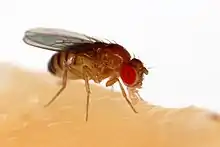Drosocin
Drosocin is a 19-residue long antimicrobial peptide (AMP) of flies first isolated in the fruit fly Drosophila melanogaster, and later shown to be conserved throughout the genus Drosophila.[1][2] Drosocin is regulated by the NF-κB Imd signalling pathway in the fly.
| Drosocin | |||||||||
|---|---|---|---|---|---|---|---|---|---|
 The fruit fly, Drosophila melanogaster | |||||||||
| Identifiers | |||||||||
| Symbol | Drosocin, Dro or Drc | ||||||||
| Pfam | DIM | ||||||||
| |||||||||
Structure and function
Drosocin is primarily active against Gram-negative bacteria. The peptide is proline-rich with proline-arginine repeats, as well a critical threonine residue. This threonine is O-glycosylated, which is required for antimicrobial activity.[1] This O-glycosylation can be performed either by mono- or disaccharides, which have different activity spectra.[3] Like the antimicrobial peptides pyrrhocoricin and abaecin, drosocin binds to bacterial DnaK, inhibiting cell machinery and replication.[4][5] The action of these drosocin-like peptides is potentiated by the presence of pore-forming peptides, which facilitates the entry of drosocin-like peptides into the bacterial cell.[6] Proline-rich peptides such as drosocin can also bind to microbe ribosomes, preventing protein translation.[7] In the absence of pore-forming peptides, the related AMP pyrrhocoricin is taken into the bacteria by the action of uptake permeases.[8]
The Drosocin gene of Drosophila neotestacea uniquely encodes tandem repeats of Drosocin mature peptides between cleavage sites. As a result, a single protein gets chopped up into multiple Drosocin peptides.[2] This tandem repeat structure is also found in the honeybee AMP apidaecin, and is hypothesized as an evolutionary mechanism to increase the speed of the immune response and AMP production.[9]
Molecular structure
The bolded threonine residue acts as a site for O-glycosylation, also found in the AMPs abaecin and pyrrhocoricin. The underlined PRP motifs are key to the binding of such peptides to the DnaK proteins of bacteria.[4][10]
D. melanogaster drosocin: GKPRPYSPRPTSHPRPIRV
Further reading
References
- Bulet P, Dimarcq JL, Hetru C, Lagueux M, Charlet M, Hegy G, Van Dorsselaer A, Hoffmann JA (July 1993). "A novel inducible antibacterial peptide of Drosophila carries an O-glycosylated substitution". The Journal of Biological Chemistry. 268 (20): 14893–7. doi:10.1016/S0021-9258(18)82417-6. PMID 8325867.
- Hanson MA, Hamilton PT, Perlman SJ (October 2016). "Immune genes and divergent antimicrobial peptides in flies of the subgenus Drosophila". BMC Evolutionary Biology. 16 (1): 228. doi:10.1186/s12862-016-0805-y. PMC 5078906. PMID 27776480.
- Uttenweiler-Joseph S, Moniatte M, Lagueux M, Van Dorsselaer A, Hoffmann JA, Bulet P (September 1998). "Differential display of peptides induced during the immune response of Drosophila: a matrix-assisted laser desorption ionization time-of-flight mass spectrometry study". Proceedings of the National Academy of Sciences of the United States of America. 95 (19): 11342–7. Bibcode:1998PNAS...9511342U. doi:10.1073/pnas.95.19.11342. PMC 21644. PMID 9736738.
- Bikker, Floris J.; Kaman-van Zanten, Wendy E.; de Vries-van de Ruit, Anne-Marij B. C.; Voskamp-Visser, Ingrid; van Hooft, Peter A. V.; Mars-Groenendijk, Roos H.; de Visser, Peter C.; Noort, Daan (2006). "Evaluation of the antibacterial spectrum of drosocin analogues". Chemical Biology & Drug Design. 68 (3): 148–153. doi:10.1111/j.1747-0285.2006.00424.x. ISSN 1747-0277. PMID 17062012. S2CID 41618771.
- Zahn M, Berthold N, Kieslich B, Knappe D, Hoffmann R, Sträter N (July 2013). "Structural studies on the forward and reverse binding modes of peptides to the chaperone DnaK". Journal of Molecular Biology. 425 (14): 2463–79. doi:10.1016/j.jmb.2013.03.041. PMID 23562829.
- Rahnamaeian M, Cytryńska M, Zdybicka-Barabas A, Dobslaff K, Wiesner J, Twyman RM, Zuchner T, Sadd BM, Regoes RR, Schmid-Hempel P, Vilcinskas A (May 2015). "Insect antimicrobial peptides show potentiating functional interactions against Gram-negative bacteria". Proceedings. Biological Sciences. 282 (1806): 20150293. doi:10.1098/rspb.2015.0293. PMC 4426631. PMID 25833860.
- Florin T, Maracci C, Graf M, Karki P, Klepacki D, Berninghausen O, Beckmann R, Vázquez-Laslop N, Wilson DN, Rodnina MV, Mankin AS (September 2017). "An antimicrobial peptide that inhibits translation by trapping release factors on the ribosome". Nature Structural & Molecular Biology. 24 (9): 752–757. doi:10.1038/nsmb.3439. PMC 5589491. PMID 28741611.
- Narayanan S, Modak JK, Ryan CS, Garcia-Bustos J, Davies JK, Roujeinikova A (May 2014). "Mechanism of Escherichia coli resistance to Pyrrhocoricin". Antimicrobial Agents and Chemotherapy. 58 (5): 2754–62. doi:10.1128/AAC.02565-13. PMC 3993218. PMID 24590485.
- Casteels-Josson, K; Capaci, T; Casteels, P; Tempst, P (1993). "Apidaecin multipeptide precursor structure: a putative mechanism for amplification of the insect antibacterial response". EMBO J. 12 (4): 1569–78. doi:10.1002/j.1460-2075.1993.tb05801.x. PMC 413370. PMID 8467807.
- Zahn, M; Straeter, N (2013). "Crystal structure of the substrate binding domain of E.coli DnaK in complex with metchnikowin (residues 20 to 26)". Protein Data Bank. doi:10.2210/pdb4EZS/pdb.